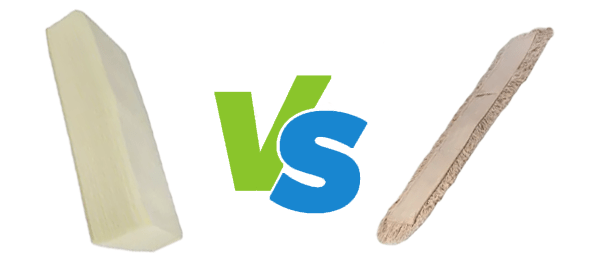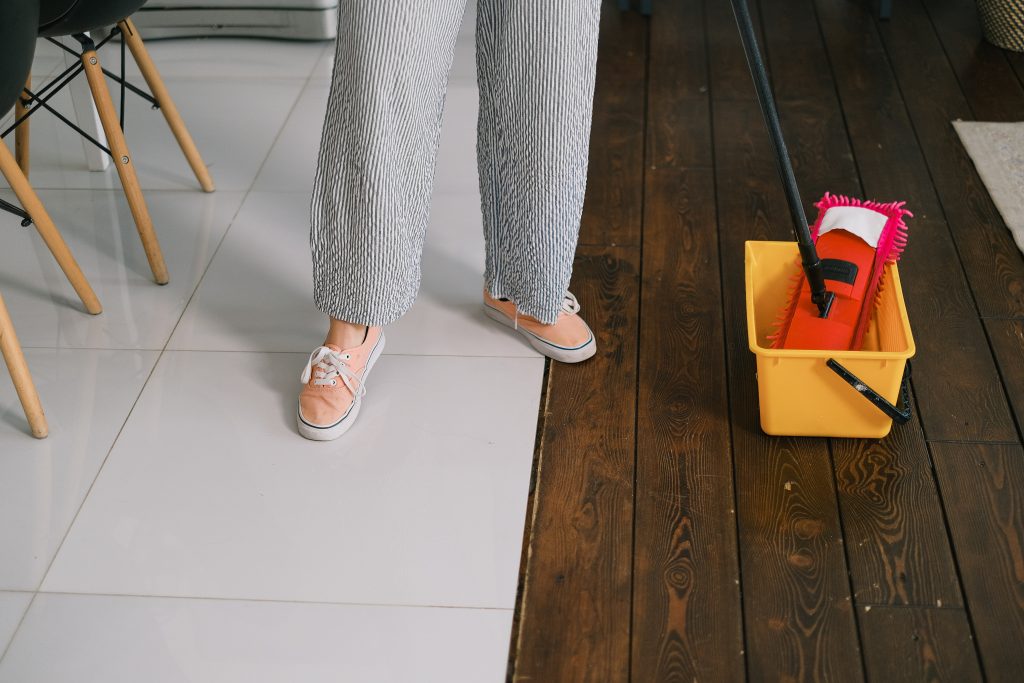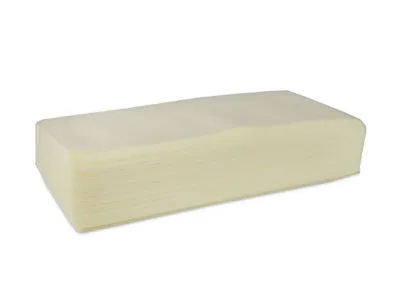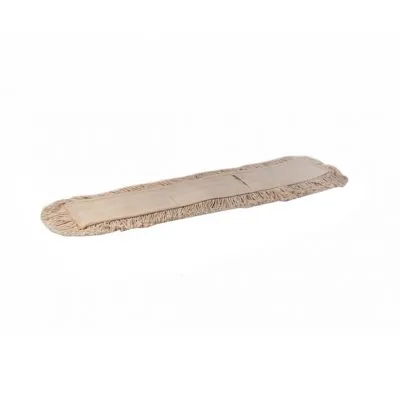Impregnated vs. Non-impregnated Dust Cloths
Dust wipers are essential tools for maintaining a clean living environment. In this blog we take a closer look at impregnated and non-impregnated dust wipers, their benefits and how you can use them optimally for thorough cleaning.
Table of contents
- What are impregnated dust wipes?
- What are non-impregnated dust wipes?
- What are the differences?
- Which type of dust mop suits you best?
- How do you use dust wipers effectively?
- Maintenance of dust wipers for optimal performance
- Conclusion
What are Impregnated Dust Cloths?
Impregnated dust wipers are cloths that have been treated with special cleaning agents, including mineral oil, for extra shine and effective dust removal during cleaning. These dusters are impregnated with chemicals, oils and other liquids that attract dust and hold it to the surface of the cloth. This makes them able to remove dust and dirt much more effectively than regular dusters.
These impregnated dust wipers are often used to clean and maintain surfaces that quickly collect dust, such as wooden furniture, shelves, electronics and screens. In addition, they can have anti-static properties, which prevent dust from re-settlement on the cleaned surface. This makes impregnated dust wipers a convenient choice for thorough and long-lasting cleaning of various surfaces in the home.
-
Dust wiper Basic Yellow 60x25cm (50x 40gr)
€4,99 inc. VAT
What are Non-impregnated Dust Cloths?
Non-impregnated dust mop cloths are ordinary cloths without special cleaning agents. They rely on their structure to absorb dust and dirt. Unlike impregnated dust wipers, they do not contain any added chemicals. These cloths are primarily intended for general dust removal and may be less effective at retaining dust particles than impregnated varieties. They are suitable for everyday dust cleaning tasks such as dusting bookshelves, tables and other surfaces. The good news is that they do not leave any residue on the cleaned surfaces.
-
Weco Mop Cover (60cm)
€11,49 inc. VAT
What are the differences?
- Cleaning power: Impregnated dust wipers usually have greater cleaning power because they can retain dust and dirt more effectively thanks to the added cleaning agents, including mineral oil. Non-impregnated cloths rely mainly on their texture.
- Specific Applications: Impregnated dust wipers are ideal for surfaces sensitive to dust and allergens, while non-impregnated cloths are more suitable for general dust removal.
- Use of Chemicals: Impregnated cloths often contain chemicals and oils, which can contribute to a deeper cleaning. Non-impregnated cloths are chemical-free and may be preferable if you are looking for a natural cleaning method.
- Costs: In general, non-impregnated dusting cloths are often cheaper than our impregnated options, which can make them a more cost-effective option for everyday cleaning tasks.
- Environmental friendliness: Non-impregnated cloths can be more environmentally friendly because they do not contain chemicals. However, our impregnated cloths are reusable, reducing the need for disposable products.
- Maintenance: Our impregnated cloths sometimes require specific maintenance to maintain the effectiveness of the cleaning agents, including mineral oil. Non-impregnated cloths usually require easier maintenance.

Which Type of Dust Cloth Suits You Best?
When it comes to choosing the right type of dust mop, it can be confusing given the variety of options on the market. To make the best choice for your specific cleaning needs and preferences, it's important to understand which type of dust mop is best for you. Here are some considerations to help with that decision:
- Cleaning power: Consider how deep you want to cleanse. If you are looking for maximum cleaning power and the removal of dust and allergens from surfaces, impregnated dust wipers are an excellent choice. They are designed to retain dust effectively thanks to the added cleaning agents.
- Specific Applications: Think about which surfaces you clean often. Impregnated dust wipers are ideal for surfaces that quickly collect dust, such as electronics, screens, and wooden furniture. Non-impregnated cloths are more suitable for general dust removal.
- Use of Chemicals: Think about your preference for using chemicals. Impregnated cloths often contain cleaning chemicals, which can contribute to a more thorough cleaning. If you prefer a natural cleaning method, non-impregnated cloths may be the better choice.
- Costs: View your budget. In general, non-impregnated dust wipes are often cheaper than impregnated versions. This makes them a more cost effective option for everyday cleaning tasks.
- Environmental friendliness: Consider the environmental friendliness. Non-impregnated cloths can be more environmentally friendly because they do not contain chemicals and are reusable. This reduces the need for disposable products.
- Maintenance: Consider which type of duster cloth best suits your maintenance preferences. Impregnated cloths sometimes require specific maintenance to maintain the effectiveness of the cleaning agents, while non-impregnated cloths are usually easier to maintain.
When choosing dust mop cloths, it is important to consider material, size and the specific needs of your household.

How Do You Use Dust Cloths Effectively?
Okay, you've chosen your favorite dusting cloths, but what's the best way to use them? Let's take a look at some helpful tips to make that dusty mission a success.
- Vacuum, then wipe: Start with a thorough vacuuming before using the dust mop. Dust wipers are great for finishing touches, but they work even better after coarser particles have been removed.
- Light-footedness is the key: Don't press too hard with your dust mop. Glide it lightly over the surface for optimal results. If you press too hard, you run the risk of sending dust particles into the air.
- Avoid wet adventures: Do not use dust wipers on wet or damp surfaces. They are designed for dry dust removal.
- One cloth, two sides: Dust wipes are reusable. Use both sides before sending them to the laundry basket.
- Be careful with fragile items: Avoid using dusting cloths on delicate items that can be easily damaged.
- Note the direction: Always start at the top and work down. This prevents dust from blowing back onto surfaces that have already been cleaned.
- Quick, short swipes: Use quick, short sweeping strokes for efficient dust removal.
Would you like a visual demonstration of these tips? Look at this video on the effective use of dust wipers. With these tips you will become the master at combating dust!

Maintenance of Dust Mop Cloths for Long Term Use
Now that you're a master at using dust mop cloths effectively, let's talk about how to keep them in top condition for long-term use. Because let's be honest, who wants to keep buying new dust mop cloths when we can take care of and reuse them?
For Non-impregnated Dust Cloths:
- Shaking is the first step: After each use session, it is a good idea to shake out your non-impregnated dust mop cloth outside. This removes most of the collected dust and prepares the cloth for the next mission.
- Wash with care: If your non-impregnated dust wipers start to get dirty, it's time for a wash. Always follow the washing instructions on the label to extend the life of your cloths.
- Replace if necessary: Even with loving care, non-impregnated dust wipers do not last forever. If you notice that they are worn, torn or dirty beyond repair, it's time to retire them and welcome a new hero into your home.
- Dust-free storage: Store your clean dusting cloths in a dust-free place, preferably in a locked cupboard or drawer. This prevents them from collecting dust while they wait for their next deployment.
With these tips you ensure that both your impregnated and non-impregnated dust wipers remain your faithful allies in the battle against dust and dirt. So, shake them, wash them with care, and give them a chance to continue their mission. Together towards a long-term dust-free future!

Conclusion
There you have it, our dive into the world of dust wipes, impregnated and non-impregnated. We learned that they both have their own specialties when it comes to dust control. Impregnated dust wipers are like the high-tech heroes that defeat dust and dirt with ease, while non-impregnated dust wipers are the reliable sidekicks for everyday, general cleaning tasks.
Curious about our range of cleaning cloths? Discover all the options available in our category 'Wiping cloths'. Click here to go to the category and find the perfect dust mop for you.
Regardless of which one you choose, the tips for effective use and maintenance will ensure they stay in top condition. And let's not forget that they help us maintain a clean, healthy environment. Whether you see your impregnated dust mop cloth as a fearless hero or your non-impregnated cloth as the faithful partner, they are both at your side to defeat dust and dirt.
Let's continue our mission to maintain a dust-free home. Choose your dust mop carefully, handle it with precision and enjoy a sparkling clean environment. And just as every adventure has its sequel, let's look to the future with the promise of a dust-free environment.


